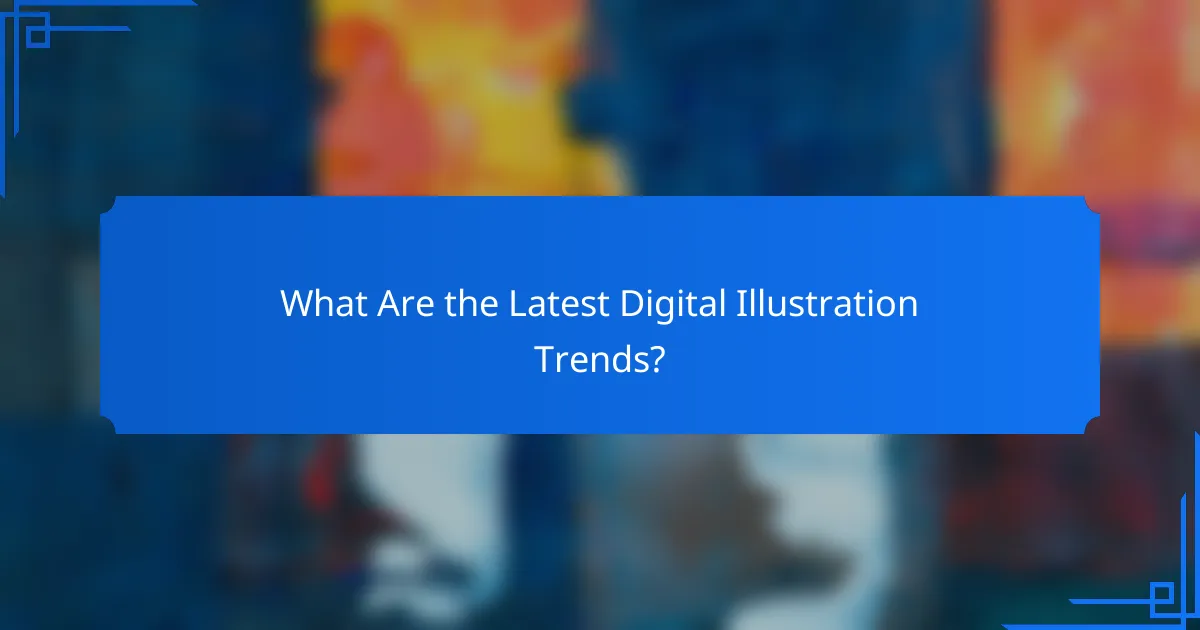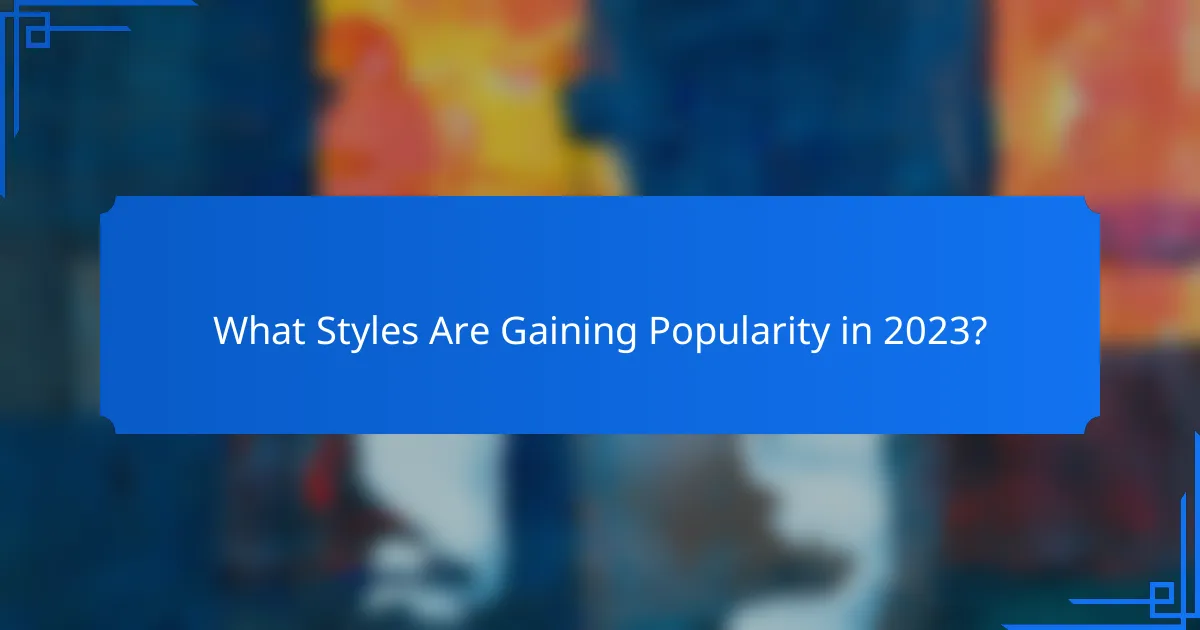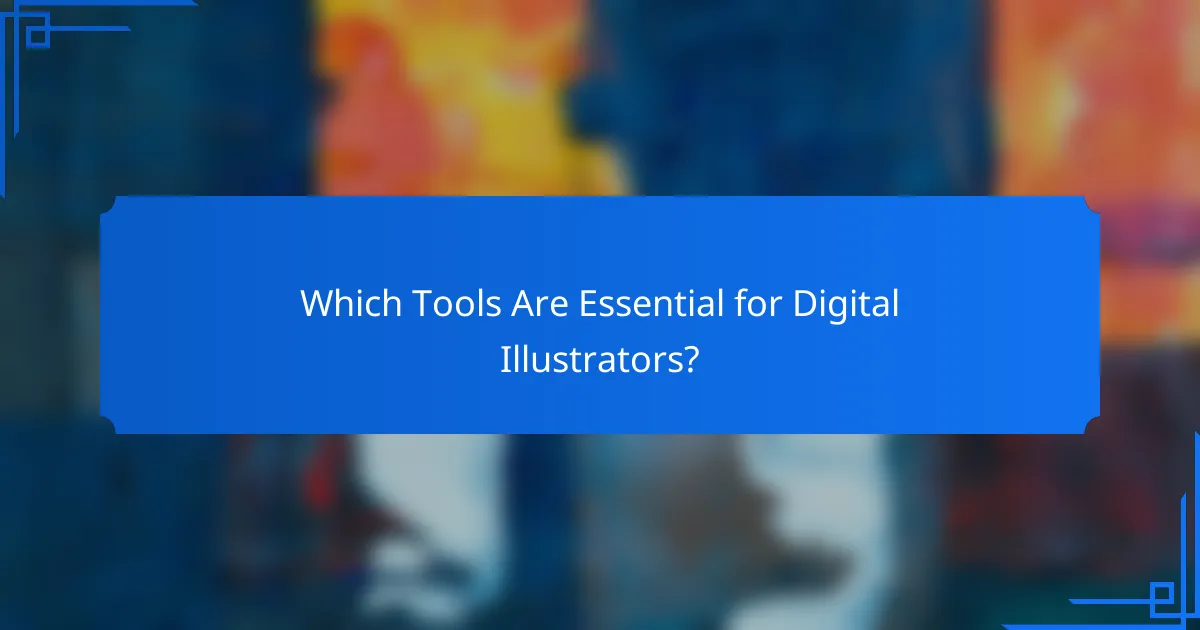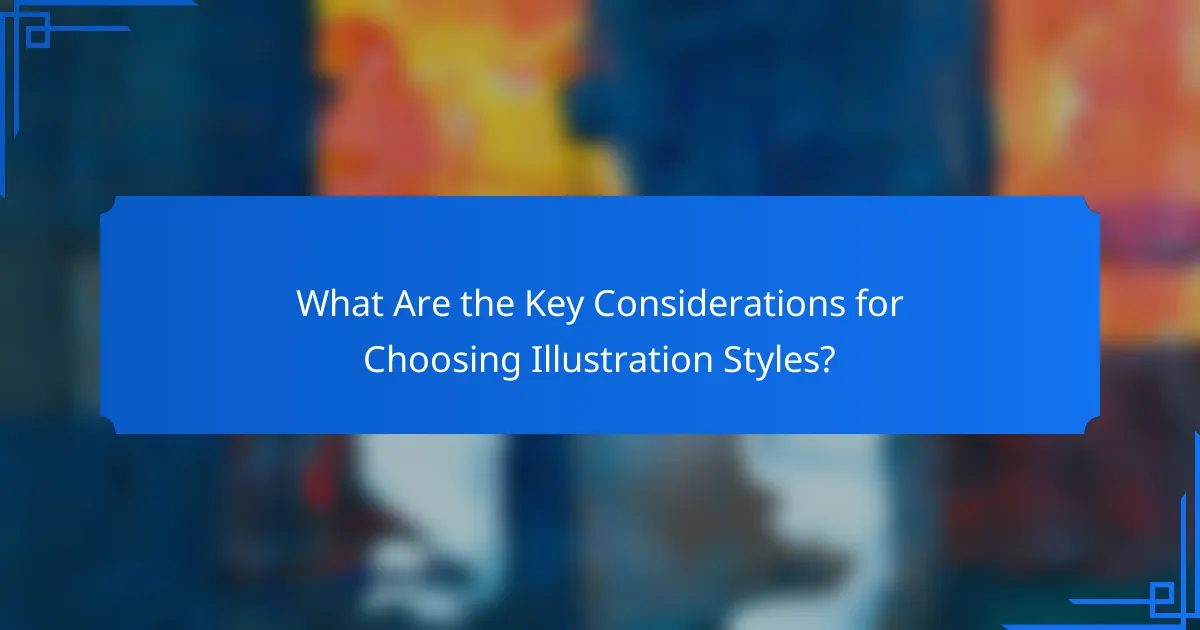As we delve into the world of digital illustration, 2023 brings forth a wave of innovative styles and techniques that redefine visual storytelling. Artists are embracing 3D methods, mixed media, and augmented reality, creating immersive experiences that captivate audiences. The influence of emerging technologies is evident, as new tools enhance creativity and streamline workflows, allowing for the exploration of unique artistic expressions.

What Are the Latest Digital Illustration Trends?
The latest digital illustration trends focus on innovative styles and techniques that enhance visual storytelling. Artists are increasingly adopting 3D techniques, mixed media, and augmented reality to create engaging and immersive experiences.
3D Illustration Techniques
3D illustration techniques are gaining traction as they allow artists to create depth and realism in their work. Tools like Blender and Cinema 4D enable the integration of textures and lighting effects that enhance visual appeal. Consider using 3D elements to add a unique perspective to traditional illustrations.
When incorporating 3D techniques, balance is key. Overly complex designs can detract from the message. Aim for a harmonious blend of 2D and 3D elements to maintain clarity and focus.
Mixed Media Approaches
Mixed media approaches combine various materials and techniques, such as digital painting, photography, and traditional drawing. This trend allows for greater creativity and personalization in illustrations. Artists can experiment with layering different media to create unique textures and effects.
To effectively use mixed media, start with a clear concept and choose complementary materials. Be mindful of how different elements interact, as some combinations may clash visually. A well-thought-out approach can lead to striking results.
Augmented Reality Integration
Augmented reality (AR) integration is transforming digital illustrations by adding interactive layers to static images. This technology enables viewers to engage with illustrations in a dynamic way, enhancing storytelling and user experience. Tools like Adobe Aero and Unity are popular for creating AR content.
When designing for AR, consider the user experience. Ensure that the interactive elements are intuitive and enhance the overall narrative rather than distract from it. Testing on various devices can help optimize performance and accessibility.
Minimalist Aesthetics
Minimalist aesthetics focus on simplicity and clarity, often using limited color palettes and clean lines. This trend emphasizes the importance of negative space, allowing the viewer to focus on essential elements. Minimalist illustrations can convey messages effectively without overwhelming the audience.
To achieve a minimalist look, prioritize essential shapes and colors. Avoid unnecessary details that may clutter the design. This approach can be particularly effective in branding and advertising, where clear communication is crucial.
Hand-Drawn Elements
Hand-drawn elements are making a comeback in digital illustration, adding a personal touch and warmth to designs. This trend often involves scanning traditional sketches and integrating them into digital platforms. Artists can use software like Procreate or Adobe Fresco to enhance these elements digitally.
Incorporating hand-drawn elements can create a unique style that resonates with audiences. However, ensure that the hand-drawn aspects align with the overall design theme. Consistency in style will help maintain visual coherence throughout the project.

How Are Technologies Shaping Digital Illustration?
Technologies are significantly influencing digital illustration by introducing innovative tools and platforms that enhance creativity and collaboration. These advancements allow artists to streamline their workflow, improve efficiency, and explore new styles and techniques.
AI-Powered Tools
AI-powered tools are revolutionizing digital illustration by automating repetitive tasks and providing creative suggestions. For instance, applications like Adobe Sensei can analyze artwork and offer enhancements or generate variations based on user input.
Artists should consider the balance between using AI for efficiency and maintaining their unique style. While these tools can save time, relying too heavily on them may dilute personal creativity. Experimenting with AI-generated elements can inspire new ideas without compromising artistic integrity.
Cloud-Based Collaboration Platforms
Cloud-based collaboration platforms enable artists to work together in real-time, regardless of their physical location. Tools like Figma and Miro allow multiple users to contribute to a project, making it easier to share feedback and iterate on designs quickly.
When using these platforms, ensure you have a clear communication strategy and version control to avoid confusion. Setting up a shared workspace with organized folders can help streamline the collaborative process and keep everyone on the same page.
Vector Graphics Software
Vector graphics software remains essential for digital illustrators, offering scalability and precision that raster images cannot match. Programs like Adobe Illustrator and CorelDRAW allow artists to create clean, scalable designs that maintain quality across various sizes.
When choosing vector software, consider your specific needs, such as compatibility with other tools and ease of use. Many programs offer trial versions, so testing a few options can help determine which best suits your workflow and style preferences.

What Styles Are Gaining Popularity in 2023?
In 2023, digital illustration is seeing a rise in styles that emphasize simplicity, nostalgia, and dreamlike elements. Artists are increasingly adopting flat design, retro aesthetics, and surrealism to create visually striking and emotionally resonant works.
Flat Design
Flat design focuses on minimalism and usability, stripping away unnecessary elements to create clean, two-dimensional visuals. This style often employs bold colors and simple shapes, making it ideal for web and mobile applications where clarity is crucial.
When using flat design, prioritize strong contrasts and a limited color palette to enhance visual impact. Avoid gradients and textures, as these can detract from the simplicity that defines this style. Popular applications include user interfaces and branding materials.
Retro and Vintage Styles
Retro and vintage styles draw inspiration from past decades, evoking nostalgia through color schemes, typography, and imagery. This trend often features muted colors and classic design elements, appealing to audiences seeking familiarity and warmth.
To effectively use retro styles, consider incorporating vintage fonts and illustrations that reflect the era you wish to evoke. Be mindful of balancing modern design principles with nostalgic elements to ensure your work feels fresh yet familiar.
Surrealism in Digital Art
Surrealism in digital art blends dreamlike imagery with unexpected juxtapositions, creating thought-provoking and imaginative pieces. This style encourages artists to explore the subconscious and challenge reality through their illustrations.
When creating surreal artwork, experiment with unconventional compositions and vibrant colors to evoke emotion and intrigue. Use digital tools to manipulate images and combine various elements, allowing for limitless creativity. Be cautious of overwhelming the viewer; maintain a sense of focus within the chaos.

Which Tools Are Essential for Digital Illustrators?
Digital illustrators rely on various tools to create their artwork, with software choices significantly impacting their workflow and final output. Key tools include Adobe Illustrator, Procreate, and Corel Painter, each offering unique features tailored to different styles and techniques.
Adobe Illustrator
Adobe Illustrator is a vector graphics editor widely used for creating scalable illustrations. Its precision and versatility make it ideal for logos, icons, and complex illustrations that require clean lines and shapes.
Key features include the Pen tool for drawing paths, a vast library of brushes, and the ability to work with layers. It supports various file formats, making it easy to integrate with other Adobe products, which is beneficial for professionals in graphic design and marketing.
When using Illustrator, consider leveraging shortcuts and custom workspaces to enhance efficiency. Be mindful of the learning curve; beginners may find it challenging but can benefit from numerous online tutorials and resources.
Procreate
Procreate is a popular digital painting app designed for the iPad, favored for its intuitive interface and extensive brush library. It’s particularly well-suited for illustrators who prefer a hands-on approach, as it mimics traditional drawing techniques.
The app offers features like customizable brushes, layering options, and the ability to create animations. Its portability allows artists to work anywhere, making it a favorite among freelancers and hobbyists alike.
To maximize Procreate’s potential, explore its time-lapse recording feature to track your progress and share your workflow. Keep in mind that while it’s user-friendly, mastering its full capabilities may take some time.
Corel Painter
Corel Painter is a digital art software that specializes in mimicking traditional painting techniques, making it a go-to for artists who want to replicate the look of oils, watercolors, and pastels. It offers a wide range of brushes and textures, allowing for a highly customizable painting experience.
This tool is particularly beneficial for illustrators focused on fine art or those who want to create detailed, textured pieces. Its robust features cater to both beginners and advanced users, with options for realistic brush strokes and blending modes.
When using Corel Painter, take advantage of its extensive library of tutorials and community forums for support. Be aware of system requirements, as it may require a powerful computer for optimal performance, especially with larger canvases.

What Are the Key Considerations for Choosing Illustration Styles?
Choosing illustration styles involves understanding the target audience, aligning with brand identity, and meeting specific project requirements. These factors ensure that the illustrations resonate with viewers and effectively communicate the intended message.
Target Audience Preferences
Understanding your target audience’s preferences is crucial when selecting illustration styles. Different demographics may respond better to certain aesthetics; for example, younger audiences might favor vibrant, playful designs, while older groups may appreciate more sophisticated and minimalistic approaches.
Conducting surveys or focus groups can provide insights into what styles appeal to your audience. Consider factors such as cultural background, interests, and industry trends to guide your choices effectively.
Brand Identity Alignment
The chosen illustration style should reflect the brand’s identity and values. Consistency in visual representation helps reinforce brand recognition and trust. For instance, a tech company may opt for sleek, modern illustrations, while a children’s brand might choose whimsical, colorful designs.
Review your brand guidelines to ensure that the illustration style complements your overall messaging and visual identity. This alignment strengthens the connection between the brand and its audience, enhancing engagement.
Project Requirements
Project requirements play a significant role in determining the appropriate illustration style. Consider the medium (digital, print, etc.), the intended use (marketing, editorial, etc.), and any specific client requests. Each of these factors can influence the complexity and style of the illustrations.
For example, a detailed infographic may require a more intricate style, while a social media post might benefit from a simpler, more eye-catching approach. Always clarify project goals and constraints to select the most effective illustration style.

How Can Digital Illustrators Stay Ahead of Trends?
Digital illustrators can stay ahead of trends by continuously exploring new styles, techniques, and technologies. Engaging with the creative community and leveraging online resources can provide insights into emerging trends and opportunities for growth.
Follow Industry Leaders
Keeping an eye on industry leaders is crucial for understanding current trends in digital illustration. Follow prominent artists on social media platforms, subscribe to their newsletters, and participate in webinars or workshops they host. This exposure can inspire new ideas and techniques that you can incorporate into your own work.
Experiment with New Tools
Digital illustration tools are constantly evolving, with new software and hardware emerging regularly. Familiarize yourself with popular programs like Procreate, Adobe Illustrator, and Clip Studio Paint, and explore innovative tools such as virtual reality (VR) and augmented reality (AR) applications. Experimenting with these technologies can enhance your creative process and set your work apart.
Engage with Online Communities
Joining online communities dedicated to digital illustration can provide valuable feedback and support. Platforms like Behance, Dribbble, and various forums allow artists to share their work, receive critiques, and discover new trends. Engaging with peers can also lead to collaborations and networking opportunities that can further your career.
Attend Workshops and Conferences
Participating in workshops and conferences focused on digital illustration can deepen your understanding of current trends and techniques. These events often feature industry experts who share insights and practical skills. Look for local or virtual events that fit your schedule and budget, as they can be a great investment in your professional development.
Stay Updated on Market Trends
Understanding market trends is essential for digital illustrators to align their work with client needs. Regularly review industry reports, follow design blogs, and monitor platforms like Pinterest and Instagram for popular styles. This awareness can help you tailor your portfolio to attract potential clients and stay relevant in a competitive landscape.


